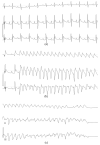Ultra-High-Resolution Electrocardiography Enables Earlier Detection of Transmural and Subendocardial Myocardial Ischemia Compared to Conventional Electrocardiography
- PMID: 37685333
- PMCID: PMC10486484
- DOI: 10.3390/diagnostics13172795
Ultra-High-Resolution Electrocardiography Enables Earlier Detection of Transmural and Subendocardial Myocardial Ischemia Compared to Conventional Electrocardiography
Abstract
The sensitivity of exercise ECG is marginally sufficient for the detection of mild reduction of coronary blood flow in patients with early coronary atherosclerosis. Here, we describe the application of a new technique of ECG registration/analysis-ultra-high-resolution ECG (UHR ECG)-for early detection of myocardial ischemia (MIS). The utility of UHR ECG vs. conventional ECG (C ECG) was tested in anesthetized rats and pigs. Transmural MIS was induced in rats by the ligation of the left coronary artery (CA). In pigs, subendocardial ischemia of a variable extent was produced by stepwise inflation of a balloon within the right CA, causing a 25-100% reduction of its lumen. In rats, a reduction in power spectral density (PSD) in the high-frequency (HF) channel of UHR ECG was registered at 60 s after ischemia (power 0.81 ± 0.14 vs. 1.25 ± 0.12 mW at baseline, p < 0.01). This was not accompanied by any ST segment elevation on C ECG. In pigs, PSD in the HF channel of UHR ECG was significantly decreased at a 25% reduction of CA lumen, while the ST segment on C ECG remained unchanged. In conclusion, UHR ECG enabled earlier detection of transmural MIS compared to C ECG. PSD in the HF channel of UHR ECG demonstrated greater sensitivity in the settings of subendocardial ischemia.
Keywords: electrocardiography; heart; ischemia; ischemic heart disease; power spectral density; reperfusion; risk stratification; sensitivity; subclinical atherosclerosis; ultra-high-resolution electrocardiography.
Conflict of interest statement
The authors declare no conflict of interest. The funders had no role in the design of the study; in the collection, analyses, or interpretation of data; in the writing of the manuscript; or in the decision to publish the results.
Figures






References
-
- Roth G.A., Mensah G.A., Johnson C.O., Addolorato G., Ammirati E., Baddour L.M., Barengo N.C., Beaton A.Z., Benjamin E.J., Benziger C.P., et al. Global burden of cardiovascular diseases and risk factors, 1990-2019: Update from the GBD 2019 study. J. Am. Coll. Cardiol. 2020;76:2982–3021. doi: 10.1016/j.jacc.2020.11.010. - DOI - PMC - PubMed
-
- Dai H., Much A.A., Maor E., Asher E., Younis A., Xu Y., Lu Y., Liu X., Shu J., Bragazzi N.L. Global, regional, and national burden of ischaemic heart disease and its attributable risk factors, 1990-2017: Results from the Global Burden of Disease Study 2017. Eur. Heart J. Qual. Care Clin. Outcomes. 2022;8:50–60. doi: 10.1093/ehjqcco/qcaa076. - DOI - PMC - PubMed
-
- Tsao C.W., Aday A.W., Almarzooq Z.I., Anderson C.A.M., Arora P., Avery C.L., Baker-Smith C.M., Beaton A.Z., Boehme A.K., Buxton A.E., et al. Heart disease and stroke statistics-2023 update: A report from the American Heart Association. Circulation. 2023;147:e93–e621. doi: 10.1161/CIR.0000000000001123. - DOI - PubMed
Grants and funding
LinkOut - more resources
Full Text Sources
Research Materials
Miscellaneous

